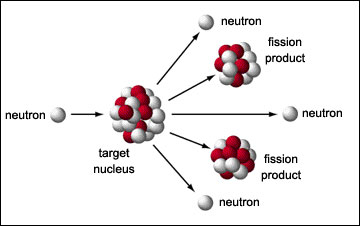Introduction
Fission is a process utilized by atomic bomb and nuclear reactor to produce energy. However, whereas nuclear reactor generates electricity, atomic bomb explodes after producing the energy. Therefore, because of these differences, nuclear reactor cannot explode like an atomic bomb. (Irvine 2011). Therefore, it is significant to understand the process of nuclear fission, which causes these differences.
The Concept of Fission Chain Reactions
Fission is the process where a neutron collides with an atom and becomes unstable; therefore, it splits and releases energy, radiation and neutrons (Irvine 2011).

This process may take place spontaneously or induced by forces like electromagnetic radiation or the excitation of the nucleus by protons, nucleus or alpha particles (Irvine 2011). This process leads to the emission of neutrons, production of energy and formation of radioactive products.

A chain reaction occurs when the neutrons released during a reaction induce fission in a nearby material that is fissionable and leads to the production of excess energy (Cadenzas 2012). The equation below illustrates the process of chain reaction: U235 + n → fission + 2 or 3 n + 200 MeV
Not all neutrons that results from fission process continue the reaction. In case the rate of losing the neutron exceeds the rate at which they are formed, the process fails to be self-sustaining. However, the point at which the process is self-sustaining is called critical mass (atomicarchive.com, 2013).
Controlled and Uncontrolled Fission
Controlled fission involves the excitation of nucleus to release energy for various industrial purposes. This is usually done in nuclear reactors where the energy produced in this reaction is used to generate power (Cadenzas 2012). On the other hand, uncontrolled fission occurs when a chain reaction is not regulated and this leads to an explosion because the energy produced is released to the environment.
The Life of a Neutron
A fission chain reaction leads to the production and multiplication of neutrons and production of energy that must be controlled (Irvine 2011). Neutrons are usually free and this explains why they sustain chemical reactions. The life of neutrons is determined by the presence or absence of control rods. These rods ensure fission chain reactions are controlled by absorbing the neutrons produced and decreasing their multiplication (Irvine 2011).
The difference
These differences are fission control and fuel enrichment. During nuclear reaction, manufacturers control and monitor closely the process. The fission reaction in atomic bomb does not need to be controlled. Therefore, it releases excess energy. The control rods regulate the reaction of nuclear. The control rods absorb neutrons to reduce the impact of multiplication. However, atomic bomb maintains all neutrons, which makes it supercritical (Wiles, 2009).
Fuel enrichment is another aspect of process that indicates diverse procedures in the process. Natural uranium cannot react to bring about the desired outcomes. Therefore, it does not act as fuel. It is entirely made up of stable materials, U238 (Wiles, 2009). U235 is added to natural uranium to increase its reactivity. The process in nuclear reactor and atomic bomb uses five and ninety percent, respectively, of enriched fuel. Therefore, there is a large multiplication factor in atomic bomb than in nuclear reactor. Explosion in nuclear reactor does not occur because the fuel used has low multiplication factor.
Conclusion
Neutrons play important roles in controlling fission chain reactions in nuclear plants and atomic bombs. The energy produced in a nuclear plant is monitored and controlled to ensure the neutrons released do not multiply to unmanageable levels. Both nuclear reactor and atomic bomb use nuclear fission to produce electricity. In atomic bomb, this electricity causes explosion. However, the nuclear reactor cannot explode because of these differences.
References
atomicarchive.com. (2013). Nuclear Fission: Basics. Web.
Cadenzas, J. (2012). The Nuclear Environmentalist: Is There a Green Road to Nuclear Energy? Torun: Copernicus Publishers.
Irvine, M. (2011). Nuclear Power: A Very Short Introduction. Oxford: Oxford University Press.
Wiles, D. R. (2009). Radioactivity: What it is and what it does. Montréal: Presses internationales Polytechnique.